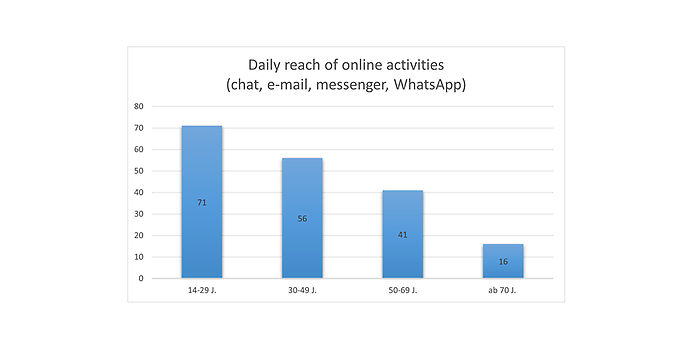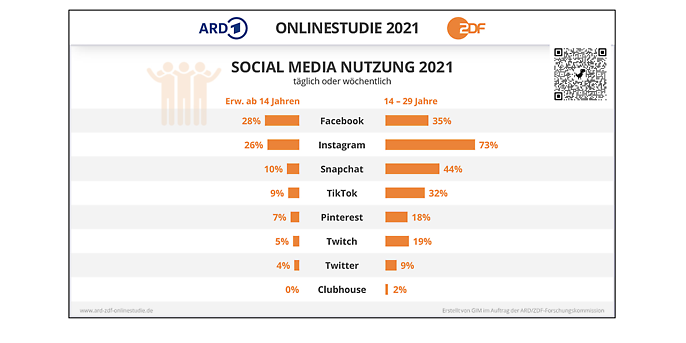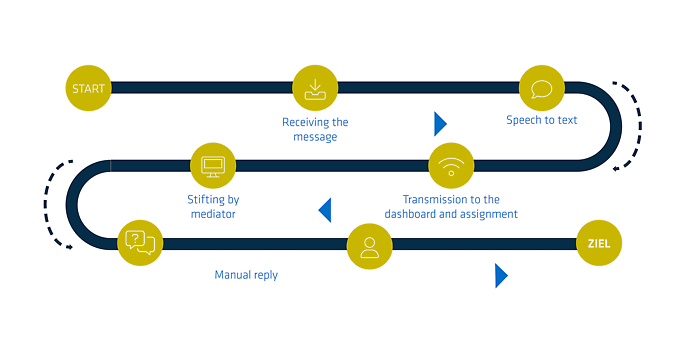20. July 2022 By Daniela König
The social media dilemma
Different customers use a variety of channels to communicate with their insurance broker.
Take, for example, Elisabeth, 60, who prefers to send everything by post and needs a paper form to file a claim. If she doesn’t use the post, she will also phone her broker. Mareike, 42, prefers to use WhatsApp to send text and voice messages to her insurance broker. Every now and then, she’ll also use e-mail. Hannah, who is 35, regularly sends her insurance broker enquiries via Facebook or Instagram. The insurance agency’s website offers this as an option. Maxi, 25, uses Telegram and Signal because the messages are more secure this way. He uses one of these two channels to contact his insurance broker. Alex, 15, prefers to use Alexa to manage everything and currently makes every call via the digital assistant. This is also his preferred channel for filing a claim or concluding an insurance policy. Levin, who is in his mid-30s, manages everything via his XING and LinkedIn account wherever possible. Another example is Jana, 40, who likes to get information from the broker’s homepage and uses the chatbots available there.
In order to focus on the needs of customers and remain competitive over the long term, insurance brokers should look into the use of communication channels described above, including validation. After all, insurance customers judge their contact based on the quality of the products they offer and based on whether they believe they can rely on them, which also means they have to be easy to reach.
Facts, figures and data
In 2019 2,000 people in four age groups were asked as part of an online study on online media use whether they use the mobile Internet for personal communication in the form of e-mail, chat, WhatsApp and other messenger services. Seventy-one per cent of respondents use this personalised form of communication regularly. Broken down further, use of messenger services is 56 per cent for respondents aged 30 to 49, 41 per cent for those aged 50 to 69 and a mere 16 per cent for those aged 70 and above, as seen in the bar graph below.

Own illustration, based on ARD/ZDF Online Study 2019: Media internet use and video-on-demand continue to gain in importance by Natalie Beisch, Wolfgang Koch and Carmen Schäfer (German-speaking population aged 14 years and over (2019: n = 2,000)
Seventy-six per cent of the German-speaking population aged 14 and over used the Internet every day in 2021. There is also a clear trend in social media use. Both Instagram and Snapchat have experienced a particularly large increase in use by users aged 14 to 29, as the ARD-ZDF online study from 2021 shows. WhatsApp is by far the most popular messenger service, followed by Telegram, Signal and Threema.

Infographic from the ARD-ZDF Online Study 2021, ARD/ZDF-Onlinestudie 2021
Challenges for insurance brokers
Insurance brokers have to adapt to new communication channels. Covid-19 has taken online communication as a whole to a new level, since in-person consultations at the broker’s office were not possible due to contact restrictions. At the beginning, phone consultations were an option. Documents were sent by e-mail only for the broker to discover a short time later that the customer did not have a printer. This meant a return to sending physical documents by post as had been done in the past. However, this approach ran counter to the sustainability strategies of the insurance companies. It became necessary to hold online video consultations. This presented a major challenge for many people and raised a whole host of questions like:
- What is the right tool?
- Is my hardware up to the task?
- How good is my Internet connection and the Internet connection of my customers?
- Is the data secure while it is being transferred?
- How does the process work in detail?
- And how can clients sign a claim?
Insurance companies began to offer tools to brokers at a discounted rate as well as webinars to teach them how to use them.
Along with these new tools, insurance brokers are also now being forced to expand their online presence in order to remain competitive. This is how insurance agencies, insurance brokers and insurance consultants came to set up pages on social media platforms. For many, however, it took too much time to maintain them. As a result, they now have social media pages, but there is no content on them. Furthermore, they do not respond to messages sent via social media, or they take a long time to get back to customers.
Requirements
Mr Winter is an insurance broker who complains that it is impossible to keep track of all the communication channels that customers use, so he tries to reduce them to a minimum. In spite of this, he still wants to meet the needs of each target group as someone who specialises in offering advisory services to every generation of customer, ranging from the silent generation up to generation alpha. He therefore makes an effort to learn about all the messenger services available.
Insurance companies and underwriters are making it more difficult for him to do this because they are using a larger number and variety of communication channels. Some also make reference to letters that are deposited on the broker’s portal, since it is prohibited to send anything unencrypted by e-mail anymore under the terms of the GDPR. Certain companies write to him or call him via Microsoft Teams, in addition to using IP telephony, while others use Skype, Zoom, Webex, GotoMeeting and GotoWebinar.
If he could, he would like to aggregate the messages he receives from customers via an array of channels in one location. Text and voice messages should both be available as options, too. At the same time, he would like to have a handy overview of the messages received from the insurance companies without first having to check several portals or answer messages across a number of different media. It would look something like this:

If Mr Winter had his way, every customer would also receive an automatic confirmation of receipt sent via the channel that the customer used to contact him. Many customers demand that the broker get back to them immediately and provide 24/7 service, especially in the case of claims. Along with that, requests for a change of address or to edit the customer’s bank account details should be automatically forwarded to the relevant insurance company. He would like to have more time to spend on the point of sale.
Measures to implement the vision
Our Broker Service team advises insurance companies, underwriters and broker pools, brokerage houses and individual brokers on a wide range of digitalisation-related topics.
Our approach
At the beginning, we document the requirements of the stakeholders in a range of different ways, such as at design thinking workshops, in the form of interviews or also as part of monitoring and running interaction rooms. After the requirements have been defined and the external framework has been adjusted, the use cases are prioritised together with the stakeholders. A customer journey and roadmap are then created. The stakeholders are shown which measures are needed to implement the prioritised requirements. The risk of misdirected investment is also minimised thanks to the expertise and experience of adesso employees.
Our team also checks which systems are already available on the market that can more or less meet the stakeholders’ requirements. We evaluate them on behalf of the stakeholders as part of an analysis of the present situation and future goals and in terms of their flexible customisation options. We also advise the client when it comes time to choose between software solutions and whether to make or buy one.
We would be happy to provide support and assistance during projects like Mr Winter’s.
You will find more exciting topics from the adesso world in our latest blog posts.

